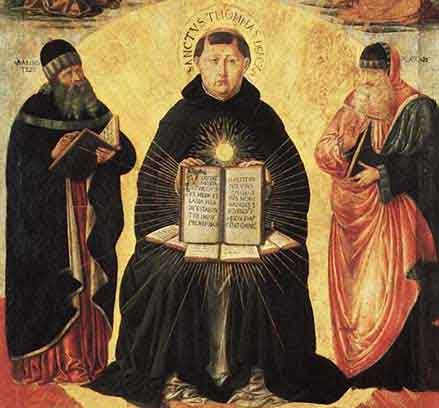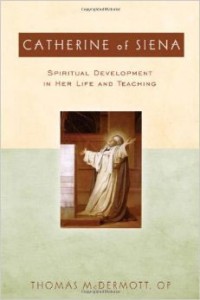[powerpress]
From a conference by Saint Thomas Aquinas, priest
(Collatio 6 super Credo in Deum)
The Cross exemplifies every virtue
Why did the Son of God have to suffer for us? There was a great need, and it can be considered in a twofold way: in the first place, as a remedy for sin, and secondly, as an example of how to act.
It is a remedy, for, in the face of all the evils which we incur on account of our sins, we have found relief through the passion of Christ. Yet, it is no less an example, for the passion of Christ completely suffices to fashion our lives. Whoever wishes to live perfectly should do nothing but disdain what Christ disdained on the cross and desire what he desired, for the cross exemplifies every virtue.
If you seek the example of love: “Greater love than this no man has, than to lay down his life for his friends.” Such a man was Christ on the cross. And if he gave his life for us, then it should not be difficult to bear whatever hardships arise for his sake.
If you seek patience, you will find no better example than the cross. Great patience occurs in two ways: either when one patiently suffers much, or when one suffers things which one is able to avoid and yet does not avoid. Christ endured much on the cross, and did so patiently, because when he suffered he did not threaten; he was led like a sheep to the slaughter and he did not open his mouth. Therefore Christ’s patience on the cross was great. In patience let us run for the prize set before us, looking upon Jesus, the author and perfecter of our faith who, for the joy set before him, bore his cross and despised the shame.
If you seek an example of humility, look upon the crucified one, for God wished to be judged by Pontius Pilate and to die.
If you seek an example of obedience, follow him who became obedient to the Father even unto death. For just as by the disobedience of one man, namely, Adam, many were made sinners, so by the obedience of one man, many were made righteous.
If you seek an example of despising earthly things, follow him who is the King of kings and the Lord of lords, in whom are hidden all the treasures of wisdom and knowledge. Upon the cross he was stripped, mocked, spat upon, struck, crowned with thorns, and given only vinegar and gall to drink.
Do not be attached, therefore, to clothing and riches, because “they divided my garments among themselves.” Nor to honours, for he experienced harsh words and scourgings. Nor to greatness of rank, for “weaving a crown of thorns they placed it on my head.” Nor to anything delightful, for “in my thirst they gave me vinegar to drink.”
Excerpts from the English translation of The Liturgy of the Hours (Four Volumes) © 1974, International Commission on English in the Liturgy Corporation. All rights reserved.
This entry was posted on Wednesday, January 28th, 2015 at 3:28 pm
You can follow any responses to this entry through the RSS 2.0 feed.
The Eighth Way of Prayer
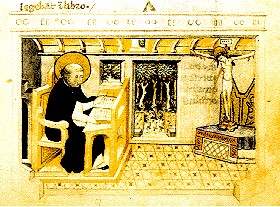 Our Father, Saint Dominic, had yet another manner of praying at once beautiful, devout, and pleasing, which he practiced after the canonical hours and the thanksgiving following meals. He was then zealous and filled with the spirit of devotion which he drew from the divine words which had been sung in the choir or refectory. Our father quickly withdrew to some solitary place, to his cell or elsewhere, and recollected himself in the presence of God. He would sit quietly, and after the sign of the cross, begin to read from a book opened before him. His spirit would then be sweetly aroused as if he heard Our Lord speaking, as we are told in the psalms: “I will hear what the Lord God will speak to me . . . (Ps. 84:9). As if disputing with a companion he would first appear somewhat impatient in his thought and words. At the next moment he would become a quiet listener, then again seem to discuss and contend. He seemed almost to laugh and weep at the same time, and then, attentively and submissively, would murmur to himself and strike his breast.
Our Father, Saint Dominic, had yet another manner of praying at once beautiful, devout, and pleasing, which he practiced after the canonical hours and the thanksgiving following meals. He was then zealous and filled with the spirit of devotion which he drew from the divine words which had been sung in the choir or refectory. Our father quickly withdrew to some solitary place, to his cell or elsewhere, and recollected himself in the presence of God. He would sit quietly, and after the sign of the cross, begin to read from a book opened before him. His spirit would then be sweetly aroused as if he heard Our Lord speaking, as we are told in the psalms: “I will hear what the Lord God will speak to me . . . (Ps. 84:9). As if disputing with a companion he would first appear somewhat impatient in his thought and words. At the next moment he would become a quiet listener, then again seem to discuss and contend. He seemed almost to laugh and weep at the same time, and then, attentively and submissively, would murmur to himself and strike his breast.
Should some curious person have desired to watch our holy father Dominic, he would have appeared to him like Moses who went into the desert, to Horeb, the sacred mountain of God, and there beheld the burning bush and heard the Lord speaking to him as he was bowed down in the divine presence. This holy custom of our father seems, as it were, to resemble the prophetic mountain of the Lord inasmuch as he quickly passed upwards from reading to prayer, from prayer to meditation, and from meditation to contemplation.
When he read alone in this solitary fashion, Dominic used to venerate the book, bow to it, and kiss it. This was especially true if he was reading the Gospels and when he had been reading the very words which had come from the mouth of Christ. At other times he would hide his face and cover it with his cappa, or bury his face in his hands and veil it slightly with the capuce. Then he would weep, all fervent and filled with holy desires. Following this, as if to render thanks to some person of great excellence for benefits received, he would reverently rise and incline his head for a short time. Wholly refreshed and, in great interior peace, he then returned to his book.
The text was taken from the book St. Dominic: Biographical Documents, edited by Fr. Francis C. Lehner, O.P. The chapter “The Nine Ways of Prayer of St. Dominic” was translated by Fr. Andrew Kolzow, O.P.
“The Nine Ways of Prayer of St. Dominic” from St. Dominic: Biographical Documents, © 1964 by The Thomist Press.
Nihil obstat: Reverend A. D. Lee, O.P. Censor Deputatus
Imprimatur: Patrick A. O’Boyle Archbishop of Washington
April 29,1964
For the complete list visit: Â 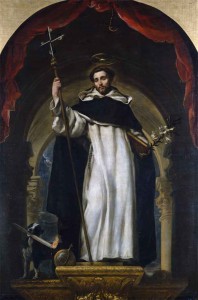
The Nine Ways of Prayer of St. Dominic
Tags: catholic, catholic podcast, catholic prayer, cathollc spirituality
This entry was posted on Friday, August 8th, 2014 at 7:48 am
You can follow any responses to this entry through the RSS 2.0 feed.
The Seventh Way of Prayer
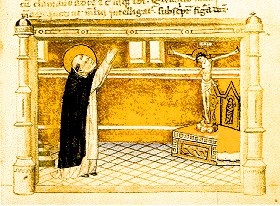 While praying, he was often seen to reach towards heaven like an arrow which has been shot from a taut bow straight upwards into the sky. He would stand with hands outstretched above his head and joined together, or at times slightly separated as if about to receive something from heaven. One would believe that he was receiving an increase of grace and in this rapture of spirit was asking God for the gifts of the Holy Spirit for the Order he had founded.
While praying, he was often seen to reach towards heaven like an arrow which has been shot from a taut bow straight upwards into the sky. He would stand with hands outstretched above his head and joined together, or at times slightly separated as if about to receive something from heaven. One would believe that he was receiving an increase of grace and in this rapture of spirit was asking God for the gifts of the Holy Spirit for the Order he had founded.
He seemed to seek for himself and his brethren something of that transcendent joy which is found in living the beatitudes, praying that each would consider himself truly blessed in extreme poverty, in bitter mourning, in cruel persecutions, in a great hunger and thirst for justice, in anxious mercy towards all. His entreaty was that his children would find their delight in observing the commandments and in the perfect practice of the evangelical counsels. Enraptured, the holy father then appeared to have entered into the Holy of Holies and the Third Heaven. After prayer of this kind he truly seemed to be a prophet, whether in correcting the faulty, in directing others, or in his preaching.
Our holy father did not remain at prayer of this type very long but gradually regained full possession of his faculties. He looked during that time like a person coming from a great distance or like a stranger in this world, as could easily be discerned from his countenance and manner. The brethren would then hear him praying aloud and saying as the prophet: “Hear, O Lord, the voice of my supplication which I pray to thee, when I lift up my hands to thy holy temple” (Ps. 27:2).
Through his words and holy example he constantly taught the friars to pray in this way, often repeating those phrases from the psalms: “Behold, now bless ye the Lord, all ye servants of the Lord … in the nights lift up your hands to the holy places, and bless ye the Lord” (Ps. 133:1-3), “I have cried to thee, O Lord, hear me; hearken to my voice when I cry to thee. Let my prayer be directed as incense in they sight; the lifting up of my hands as the evening sacrifice” (Ps. 140:1-2). The drawing shows us this mode of prayer so that we may better understand it.
The text was taken from the book St. Dominic: Biographical Documents, edited by Fr. Francis C. Lehner, O.P. The chapter “The Nine Ways of Prayer of St. Dominic” was translated by Fr. Andrew Kolzow, O.P.
“The Nine Ways of Prayer of St. Dominic” from St. Dominic: Biographical Documents, © 1964 by The Thomist Press.
Nihil obstat: Reverend A. D. Lee, O.P. Censor Deputatus
Imprimatur: Patrick A. O’Boyle Archbishop of Washington
April 29,1964
For the complete list visit: Â 
The Nine Ways of Prayer of St. Dominic
Tags: catholic, catholic podcast, catholic prayer, cathollc spirituality
This entry was posted on Thursday, August 7th, 2014 at 1:29 pm
You can follow any responses to this entry through the RSS 2.0 feed.
The Sixth Way of Prayer
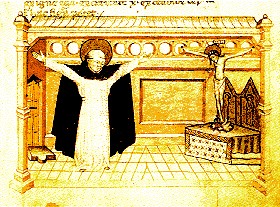 Our holy Father, Saint Dominic, was also seen to pray standing erect with his hands and arms outstretched forcefully in the form of a cross. He prayed in this way when God, through his supplications, raised to life the boy Napoleon in the sacristy of the Church of Saint Sixtus in Rome, and when he was raised from the ground at the celebration of Mass, as the good and holy Sister Cecilia, who was present with many other people and saw him, narrates. He was like Elias who stretched himself out and lay upon the widow’s son when he raised him to life.
Our holy Father, Saint Dominic, was also seen to pray standing erect with his hands and arms outstretched forcefully in the form of a cross. He prayed in this way when God, through his supplications, raised to life the boy Napoleon in the sacristy of the Church of Saint Sixtus in Rome, and when he was raised from the ground at the celebration of Mass, as the good and holy Sister Cecilia, who was present with many other people and saw him, narrates. He was like Elias who stretched himself out and lay upon the widow’s son when he raised him to life.
In a similar manner he prayed near Toulouse when he delivered the group of English pilgrims from danger of drowning in the river. Our Lord prayed thus while hanging on the cross, that is, with his hands and arms extended and “with a loud cry and tears … he was heard because of his reverent submission” [Heb. 5:7].
Nor did the holy man Dominic resort to this manner of praying unless he was inspired by God to know that something great and marvelous was to come about through the power of his prayer. Although he did not forbid the brethren to pray in this way, neither did he encourage them to do so. We do not know what he said when he stood with his hands and arms extended in the form of a cross and raised the boy to life. Perhaps it was those words of Elias: “O Lord, my God, let the soul of this child, I beseech thee, return into his body” (III Kings 17:21). He certainly followed the prophet’s exterior manner in his prayers on that occasion. The friars and sisters, however, as well as the nobles and cardinals, and all others present were so struck by this most unusual and astonishing way of prayer that they failed to remember the words he spoke. Afterwards, they did not feel free to ask Dominic about these matters because this holy and remarkable man inspired in them a great sense of awe and reverence by reason of the miracle.
In a grave and mature manner, he would slowly pronounce the words in the Psalter which mention this way of prayer. He used to say attentively: “O Lord, the God of my salvation: I have cried in the day and in the night before thee,” as far as that verse “All the day I have cried to thee, O Lord: I stretched out my hands to thee” (Ps. 87:2-10). Then he would add: “Hear, O Lord, my prayer give ear to my supplication in thy truth . . .” He would continue the prayer to these words: “I stretched forth my hands to thee . . . Hear me speedily, O Lord” (Ps. 142:1-7).
This example of our father’s prayer would help devout souls to appreciate more easily his great zeal and wisdom in praying thus. This is true whether, in doing so, he wished to move God in some wonderful manner through his prayer or whether he felt through some interior inspiration that God was to move him to seek some singular grace for himself or his neighbor. He then shone with the spiritual insight of David, the ardor of Elias, the charity of Christ, and with a profound devotion, as the drawing serves to indicate.
The text was taken from the book St. Dominic: Biographical Documents, edited by Fr. Francis C. Lehner, O.P. The chapter “The Nine Ways of Prayer of St. Dominic” was translated by Fr. Andrew Kolzow, O.P.
“The Nine Ways of Prayer of St. Dominic” from St. Dominic: Biographical Documents, © 1964 by The Thomist Press.
Nihil obstat: Reverend A. D. Lee, O.P. Censor Deputatus
Imprimatur: Patrick A. O’Boyle Archbishop of Washington
April 29,1964
For the complete list visit: Â 
The Nine Ways of Prayer of St. Dominic
Tags: catholic, catholic podcast, catholic prayer, cathollc spirituality
This entry was posted on Wednesday, August 6th, 2014 at 6:57 am
You can follow any responses to this entry through the RSS 2.0 feed.
The Fifth Way of Prayer
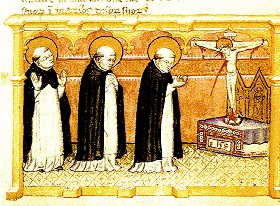 When he was in the convent, our holy father Dominic would sometimes remain before the altar, standing erect without supporting himself or leaning upon anything. Often his hands would be extended before his breast in the manner of an open book; he would stand with great reverence and devotion as if reading in the very presence of God. Deep in prayer, he appeared to be meditating upon the words of God, and he seemed to repeat them to himself in a sweet voice. He regularly prayed in this way for it was Our Lord’s manner as Saint Luke tells us: “. . . according to his custom he entered the synagogue on the Sabbath and began to read” [Luke 4:16]. The psalmist also tells us that “Phinees stood up and prayed, and the slaughter ceased” [Ps. 105:30].
When he was in the convent, our holy father Dominic would sometimes remain before the altar, standing erect without supporting himself or leaning upon anything. Often his hands would be extended before his breast in the manner of an open book; he would stand with great reverence and devotion as if reading in the very presence of God. Deep in prayer, he appeared to be meditating upon the words of God, and he seemed to repeat them to himself in a sweet voice. He regularly prayed in this way for it was Our Lord’s manner as Saint Luke tells us: “. . . according to his custom he entered the synagogue on the Sabbath and began to read” [Luke 4:16]. The psalmist also tells us that “Phinees stood up and prayed, and the slaughter ceased” [Ps. 105:30].
He would sometimes join his hands, clasping them firmly together before eyes filled with tears and restrain himself. At other times he would raise his hands to his shoulders as the priest does at Mass. He appeared then to be listening carefully as if to hear something spoken from the altar. If one had seen his great devotion as he stood erect and prayed, he would certainly have thought that he was observing a prophet, first speaking with an angel or with God himself, then listening, then silently thinking of those things which had been revealed to him.
On a journey he would secretly steal away at the time for prayer and, standing, would immediately raise his mind to heaven. One would then have heard him speaking sweetly and with supreme delight some loving words from his heart and from the riches of Holy Scripture which he seemed to draw from the fountains of the Savior. The friars were very much moved by the sight of their father and master praying in this manner. Thus, having become more fervent, they were instructed in the way of reverent and constant prayer: “Behold as the eyes of servants are on the hands of their masters, as the eyes of the handmaid are on the hands of her mistress . . .” [Ps. 122:2].
The text was taken from the book St. Dominic: Biographical Documents, edited by Fr. Francis C. Lehner, O.P. The chapter “The Nine Ways of Prayer of St. Dominic” was translated by Fr. Andrew Kolzow, O.P.
“The Nine Ways of Prayer of St. Dominic” from St. Dominic: Biographical Documents, © 1964 by The Thomist Press.
Nihil obstat: Reverend A. D. Lee, O.P. Censor Deputatus
Imprimatur: Patrick A. O’Boyle Archbishop of Washington
April 29,1964
For the complete list visit: Â 
The Nine Ways of Prayer of St. Dominic
Tags: catholic, catholic podcast, catholic prayer, cathollc spirituality
This entry was posted on Tuesday, August 5th, 2014 at 6:43 am
You can follow any responses to this entry through the RSS 2.0 feed.
The Nine Ways of Prayer of St. Dominic
[powerpress]
The Fourth Way of Prayer
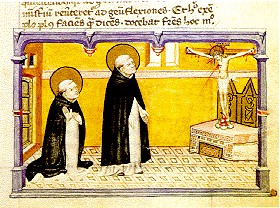 After this, Saint Dominic would remain before the altar or in the chapter room with his gaze fixed on the Crucified One, looking upon Him with perfect attention. He genuflected frequently, again and again. He would continue sometimes from after Compline until midnight, now rising, now kneeling again, like the apostle Saint James, or the leper of the gospel who said on bended knee: “Lord, if thou wilt, thou canst make me clean” [Matt. 8:2]. He was like Saint Stephen who knelt and called out with a loud cry: “Lord, do not lay this sin against them” [Acts 7:60]. Thus there was formed in our holy father, Saint Dominic, a great confidence in God’s mercy towards himself, all sinners, and for the perseverance of the younger brethren whom he sent forth to preach to souls. Sometimes he could not even restrain his voice, and the friars would hear him murmuring: “Unto thee will I cry, O Lord: O my God, be not thou silent to me: lest if thou be silent to me, I become like them that go down into the pit” [Ps. 27:1] and comparable phrases from the Sacred Scripture.
After this, Saint Dominic would remain before the altar or in the chapter room with his gaze fixed on the Crucified One, looking upon Him with perfect attention. He genuflected frequently, again and again. He would continue sometimes from after Compline until midnight, now rising, now kneeling again, like the apostle Saint James, or the leper of the gospel who said on bended knee: “Lord, if thou wilt, thou canst make me clean” [Matt. 8:2]. He was like Saint Stephen who knelt and called out with a loud cry: “Lord, do not lay this sin against them” [Acts 7:60]. Thus there was formed in our holy father, Saint Dominic, a great confidence in God’s mercy towards himself, all sinners, and for the perseverance of the younger brethren whom he sent forth to preach to souls. Sometimes he could not even restrain his voice, and the friars would hear him murmuring: “Unto thee will I cry, O Lord: O my God, be not thou silent to me: lest if thou be silent to me, I become like them that go down into the pit” [Ps. 27:1] and comparable phrases from the Sacred Scripture.
At other times, however, he spoke within himself and his voice could not be heard. He would remain in genuflection for a long while, rapt in spirit; on occasion, while in this position, it appeared from his face that his mind had penetrated heaven and soon he reflected an intense joy as he wiped away the flowing tears. He was in a stage of longing and anticipation like a thirsty man who has reached a spring, and like a traveler who is at last approaching his homeland. Then he would become more absorbed and ardent as he moved in an agile manner but with great grace, now arising, now genuflecting. He was so accustomed to bend his knees to God in this way that when he traveled, in the inns after a weary journey, or along the wayside while his companions rested or slept, he would return to these genuflections, his own intimate and personal form of worship. This way of prayer he taught his brethren more by example than by words.
The text was taken from the book St. Dominic: Biographical Documents, edited by Fr. Francis C. Lehner, O.P. The chapter “The Nine Ways of Prayer of St. Dominic” was translated by Fr. Andrew Kolzow, O.P.
“The Nine Ways of Prayer of St. Dominic” from St. Dominic: Biographical Documents, © 1964 by The Thomist Press.
Nihil obstat: Reverend A. D. Lee, O.P. Censor Deputatus
Imprimatur: Patrick A. O’Boyle Archbishop of Washington
April 29,1964
For the complete list visit: Â 
The Nine Ways of Prayer of St. Dominic
Tags: catholic, catholic podcast, catholic prayer, cathollc spirituality
This entry was posted on Sunday, August 3rd, 2014 at 6:22 am
You can follow any responses to this entry through the RSS 2.0 feed.
The Nine Ways of Prayer of St. Dominic
[powerpress]
The Third Way of Prayer
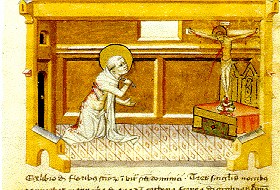 At the end of the prayer which has just been described, Saint Dominic would rise from the ground and give himself the discipline with an iron chain, saying, “Thy discipline has corrected me unto the end” [Ps. 17:36]. This is why the Order decreed, in memory of his example, that all the brethren should receive the discipline with wooden switches upon their shoulders as they were bowing down in worship and reciting the psalm “Miserere” or “De Profundis” after Compline on ferial days. This is performed for their own faults or for those of others whose alms they receive and rely upon. No matter how sinless he may be, no one is to desist from this holy example which is shown in the drawing.
At the end of the prayer which has just been described, Saint Dominic would rise from the ground and give himself the discipline with an iron chain, saying, “Thy discipline has corrected me unto the end” [Ps. 17:36]. This is why the Order decreed, in memory of his example, that all the brethren should receive the discipline with wooden switches upon their shoulders as they were bowing down in worship and reciting the psalm “Miserere” or “De Profundis” after Compline on ferial days. This is performed for their own faults or for those of others whose alms they receive and rely upon. No matter how sinless he may be, no one is to desist from this holy example which is shown in the drawing.
The text was taken from the book St. Dominic: Biographical Documents, edited by Fr. Francis C. Lehner, O.P. The chapter “The Nine Ways of Prayer of St. Dominic” was translated by Fr. Andrew Kolzow, O.P.
“The Nine Ways of Prayer of St. Dominic” from St. Dominic: Biographical Documents, © 1964 by The Thomist Press.
Nihil obstat: Reverend A. D. Lee, O.P. Censor Deputatus
Imprimatur: Patrick A. O’Boyle Archbishop of Washington
April 29,1964
For the complete list visit: Â 
The Nine Ways of Prayer of St. Dominic
Tags: catholic, catholic podcast, catholic prayer, cathollc spirituality
This entry was posted on Saturday, August 2nd, 2014 at 2:53 pm
You can follow any responses to this entry through the RSS 2.0 feed.
The Nine Ways of Prayer of St. Dominic
[powerpress]
The Second Way of Prayer
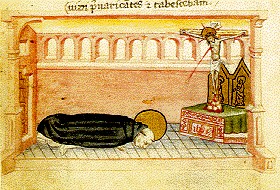 St. Dominic used to pray by throwing himself outstretched upon the ground, lying on his face. He would feel great remorse in his heart and call to mind those words of the Gospel, saying sometimes in a voice loud enough to be heard: “O God, be merciful to me, a sinner.” [Luke 18:13] With devotion and reverence he repeated that verse of David: “I am he that has sinned, I have done wickedly.” [II Kings 24:17]. Then he would weep and groan vehemently and say: “I am not worthy to see the heights of heaven because of the greatness of my iniquity, for I have aroused thy anger and done what is evil in thy sight”(28). From the psalm: “Deus auribus nostris audivimus” he said fervently and devoutly: “For our soul is cast down to the dust, our belly is flat on the earth!” [Ps. 43:25]. To this he would add: “My soul is prostrate in the dust; quicken thou me according to thy word” [Ps. 118:25].
St. Dominic used to pray by throwing himself outstretched upon the ground, lying on his face. He would feel great remorse in his heart and call to mind those words of the Gospel, saying sometimes in a voice loud enough to be heard: “O God, be merciful to me, a sinner.” [Luke 18:13] With devotion and reverence he repeated that verse of David: “I am he that has sinned, I have done wickedly.” [II Kings 24:17]. Then he would weep and groan vehemently and say: “I am not worthy to see the heights of heaven because of the greatness of my iniquity, for I have aroused thy anger and done what is evil in thy sight”(28). From the psalm: “Deus auribus nostris audivimus” he said fervently and devoutly: “For our soul is cast down to the dust, our belly is flat on the earth!” [Ps. 43:25]. To this he would add: “My soul is prostrate in the dust; quicken thou me according to thy word” [Ps. 118:25].
Wishing to teach the brethren to pray reverently, he would sometimes say to them: When those devout Magi entered the dwelling they found the child with Mary, his mother, and falling down they worshipped him. There is no doubt that we too have found the God-Man with Mary, his handmaid. “Come, let us adore and fall down in prostration before God, and let us weep before God, and let us weep before the Lord that made us” [Ps. 94:61. He would also exhort the young men, and say to them: If you cannot weep for your own sins because you have none, remember that there are many sinners who can be disposed for mercy and charity. It was for these that the prophets lamented; and when Jesus saw them, he wept bitterly. The holy David also wept as he said: “I beheld the transgressors and began to grieve” [Ps. 118:158].
The text was taken from the book St. Dominic: Biographical Documents, edited by Fr. Francis C. Lehner, O.P. The chapter “The Nine Ways of Prayer of St. Dominic” was translated by Fr. Andrew Kolzow, O.P.
“The Nine Ways of Prayer of St. Dominic” from St. Dominic: Biographical Documents, © 1964 by The Thomist Press.
Nihil obstat: Reverend A. D. Lee, O.P. Censor Deputatus
Imprimatur: Patrick A. O’Boyle Archbishop of Washington
April 29,1964
For the complete list visit: Â 
The Nine Ways of Prayer of St. Dominic
Tags: catholic, catholic podcast, catholic prayer, cathollc spirituality
This entry was posted on Friday, August 1st, 2014 at 5:45 am
You can follow any responses to this entry through the RSS 2.0 feed.
The Nine Ways of Prayer of St. Dominic
Holy teachers like Augustine, Ambrose, Gregory, Hilary, Isidore, John Chrysostom, John Damascene, Bernard, and other saintly Greek and Latin doctors have discoursed on prayer at great length. They have encouraged and described it, pointed out its necessity and value, explained the method, the dispositions which are required, and the impediments which stand in its way. In learned books, the glorious and venerable doctor, Brother Thomas Aquinas, and Albert, of the Order of Preachers, as well as William in his treatise on the virtues, have considered admirably and in a holy, devout, and beautiful manner that form of prayer in which the soul makes use of the members of the body to raise itself more devoutly to God. In this way the soul, in moving the body, is moved by it. At times it becomes rapt in ecstasy as was Saint Paul, or is caught up in a rapture of the spirit like the prophet David. Saint Dominic often prayed in this way, and it is fitting that we say something of his method.
Certainly many saints of both the Old and New Testament are known to have prayed like this at times. Such a method serves to enkindle devotion by the alternate action of soul upon body and body upon soul. Prayer of this kind would cause Saint Dominic to be bathed in tears, and would arouse the fervor of his holy will to such intensity that his bodily members could not be restrained from manifesting his devotion by certain signs. As a result, the spirit of the supplicant was sometimes raised up during its entreaties, petitions, and thanksgivings.
The following, then, are the special modes of prayer, besides those very devout and customary forms, which Saint Dominic used during the celebration of Mass and the praying of the psalmody. In choir or along the road, he was often seen lifted suddenly out of himself and raised up with God and the angels.
The First Way of Prayer
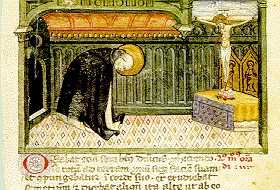 Saint Dominic’s first way of prayer was to humble himself before the altar as if Christ, signified by the altar, were truly and personally present and not in symbol alone. He would say with Judith: “O Lord, God, the prayer of the humble and the meek hath always pleased Thee [Judith 9:16]. “It was through humility that the Canaanite woman and the prodigal son obtained what they desired; as for me, “I am not worthy that Thou shouldst come under my roof” [Matt. 8:8] for “I have been humbled before you exceedingly, O Lord [Ps. 118:107].:
Saint Dominic’s first way of prayer was to humble himself before the altar as if Christ, signified by the altar, were truly and personally present and not in symbol alone. He would say with Judith: “O Lord, God, the prayer of the humble and the meek hath always pleased Thee [Judith 9:16]. “It was through humility that the Canaanite woman and the prodigal son obtained what they desired; as for me, “I am not worthy that Thou shouldst come under my roof” [Matt. 8:8] for “I have been humbled before you exceedingly, O Lord [Ps. 118:107].:
In this way our holy father, standing erect, bowed his head and humbly considering Christ, his Head, compared his lowliness with the excellence of Christ. He then gave himself completely in showing his veneration. The brethren were taught to do this whenever they passed before the humiliation of the Crucified One in order that Christ, so greatly humbled for us, might see us humbled before his majesty. And he commanded the friars to humble themselves in this way before the entire Trinity whenever they chanted solemnly: “Glory be to the Father, and to the Son, and to the Holy Spirit.” In this manner of profoundly inclining his head, as shown in the drawing, Saint Dominic began his prayer.
The text was taken from the book St. Dominic: Biographical Documents, edited by Fr. Francis C. Lehner, O.P. The chapter “The Nine Ways of Prayer of St. Dominic” was translated by Fr. Andrew Kolzow, O.P.
“The Nine Ways of Prayer of St. Dominic” from St. Dominic: Biographical Documents, © 1964 by The Thomist Press.
Nihil obstat: Reverend A. D. Lee, O.P. Censor Deputatus
Imprimatur: Patrick A. O’Boyle Archbishop of Washington
April 29,1964
Tags: catholic, catholic podcast, catholic prayer, cathollc spirituality
This entry was posted on Thursday, July 31st, 2014 at 7:42 pm
You can follow any responses to this entry through the RSS 2.0 feed.
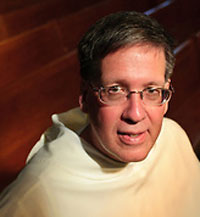 Episode 8Â St. Catherine of Siena: Her Life and Teachings with Fr. Thomas McDermott
Episode 8Â St. Catherine of Siena: Her Life and Teachings with Fr. Thomas McDermott
[powerpress]
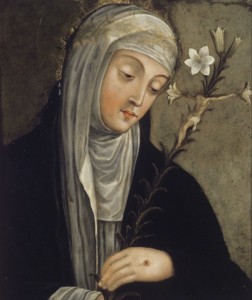 In this final episode, Fr. McDermott discuss the final step of the spiritual life which is actually comprised of two stages: “perfect love” and  “perfect union”. On the “Christ-Bridge” we find ourselves with St. Catherine at the “mouth” of Christ which corresponds to the first chapter of the “Song of Songs”.  Fr. McDermott expands on St. Catherine’s teachings on the role we have as sons and daughters of the Father.
In this final episode, Fr. McDermott discuss the final step of the spiritual life which is actually comprised of two stages: “perfect love” and  “perfect union”. On the “Christ-Bridge” we find ourselves with St. Catherine at the “mouth” of Christ which corresponds to the first chapter of the “Song of Songs”.  Fr. McDermott expands on St. Catherine’s teachings on the role we have as sons and daughters of the Father.
Fr. McDermott then offers a summation of St. Catherine’s teachings as a conclusion for our discussions.
Fr. Thomas McDermott, OP is Regent of Studies for the Dominican Province of St. Albert the Great and is the author of “Catherine of Siena: Spiritual Development in Her Life and Teaching” (Paulist, 2008) and “Filled with all the Fullness of God: An Introduction to Catholic Spirituality”. He obtained a doctorate in spiritual theology from the Angelicum and taught for several years at Kenrick-Glennon Seminary in St. Louis. He crrently serves as pastor at St. Vincent Ferrer, in Chicago, IL.
Tags: catholic, catholic podcast, catholic prayer, cathollc spirituality, McDermott, st catherine of siena, Thomas McDermott
This entry was posted on Tuesday, April 29th, 2014 at 5:24 am
You can follow any responses to this entry through the RSS 2.0 feed.
 Episode 6 St. Catherine of Siena: Her Life and Teachings with Fr. Thomas McDermott
Episode 6 St. Catherine of Siena: Her Life and Teachings with Fr. Thomas McDermott
[powerpress]
 In this episode, Fr. McDermott aids in our understanding of St. Catherine’s teachings on the “Blood of Christ” and it’s context from Sacred Scripture and Medieval sensibilities.  He discusses “The Christ Bridge” as a central image in St. Catherine’s writings one’s spiritual journey.  The flowering of baptismal grace is exemplified in this teaching.
In this episode, Fr. McDermott aids in our understanding of St. Catherine’s teachings on the “Blood of Christ” and it’s context from Sacred Scripture and Medieval sensibilities.  He discusses “The Christ Bridge” as a central image in St. Catherine’s writings one’s spiritual journey.  The flowering of baptismal grace is exemplified in this teaching.
Fr. Thomas McDermott, OP is Regent of Studies for the Dominican Province of St. Albert the Great and is the author of “Catherine of Siena: Spiritual Development in Her Life and Teaching” (Paulist, 2008) and “Filled with all the Fullness of God: An Introduction to Catholic Spirituality”. He obtained a doctorate in spiritual theology from the Angelicum and taught for several years at Kenrick-Glennon Seminary in St. Louis. He crrently serves as pastor at St. Vincent Ferrer, in Chicago, IL.
Tags: McDermott, st catherine of siena, Thomas McDermott
This entry was posted on Thursday, April 10th, 2014 at 5:00 pm
You can follow any responses to this entry through the RSS 2.0 feed.
 Episode 5 St. Catherine of Siena: Her Life and Teachings with Fr. Thomas McDermott
Episode 5 St. Catherine of Siena: Her Life and Teachings with Fr. Thomas McDermott
[powerpress]
 In this episode, Fr. McDermott  begins a more generalized discussion on the teachings of St. Catherine of Siena.
In this episode, Fr. McDermott  begins a more generalized discussion on the teachings of St. Catherine of Siena.
Fr. McDermott speaks of “The Dialogue” and how it came to be.  Some of the basic teachings of St. Catherine are presented such as “The Truth of God the Father”.  He relates the motto of the  Dominican order, “Veritas” (Truth), was foundational for St. Catherine.  The Supreme Truth about God and the truth of the human person.  Fr. McDermott also touches on St. Catherine’s teachings on sin, selfish self-love in particular.  How do we arrive at “truth”?  Prayer is key, along with the Scriptures and the Sacraments.  Also St. Catherine’s teachings on discernment, humility, love, patience and obedience, as well as, the doctrine of deification, is addressed.
Fr. Thomas McDermott, OP is Regent of Studies for the Dominican Province of St. Albert the Great and is the author of “Catherine of Siena: Spiritual Development in Her Life and Teaching” (Paulist, 2008) and “Filled with all the Fullness of God: An Introduction to Catholic Spirituality”. He obtained a doctorate in spiritual theology from the Angelicum and taught for several years at Kenrick-Glennon Seminary in St. Louis. He crrently serves as pastor at St. Vincent Ferrer, in Chicago, IL.
Tags: McDermott, st catherine of siena, Thomas McDermott
This entry was posted on Friday, March 21st, 2014 at 2:37 pm
You can follow any responses to this entry through the RSS 2.0 feed.
 Episode 3 St. Catherine of Siena:  Her Life and Teachings with Fr. Thomas McDermott-
Episode 3 St. Catherine of Siena:  Her Life and Teachings with Fr. Thomas McDermott-
[powerpress]
 In this episode, Fr. McDermott discusses the experience of St. Catherine’s “Mystical Espousal” and it’s spiritual relevance.
In this episode, Fr. McDermott discusses the experience of St. Catherine’s “Mystical Espousal” and it’s spiritual relevance.
 The virtues are discussed as central to St. Catherine’s teachings and the importance of properly understanding their value in our lives.  The response to the needs of one’s neighbor is emphasized.  In particular, the special interaction with Andrea, the woman with cancer, is presented as an extraordinary moment of grace which aided in St. Catherine’s spiritual maturity and growth in holiness.  Fr. McDermott addresses the contemporary “controversy” over the actions taken in this particular experience.Â
The other experiences of the summer 1380, the exchange of hearts the mystical death are discussed, as well as, the saint’s invisible stigmata.
Fr. Thomas McDermott, OP is Regent of Studies for the Dominican Province of St. Albert the Great and is the author of “Catherine of Siena: Spiritual Development in Her Life and Teaching” (Paulist, 2008) and  “Filled with all the Fullness of God: An Introduction to Catholic Spirituality”.  He obtained a doctorate in spiritual theology from the Angelicum and taught for several years at Kenrick-Glennon Seminary in St. Louis.  He crrently serves as pastor at St. Vincent Ferrer, in Chicago, IL.
Our series is based on “Catherine of Siena”
by Fr. McDermott
Tags: catherine of siena, st catherine of siena, Thomas McDermott
This entry was posted on Wednesday, February 5th, 2014 at 11:59 am
You can follow any responses to this entry through the RSS 2.0 feed.
 Episode 2 St. Catherine of Siena:  Her Life and Teachings with Fr. Thomas McDermott-
Episode 2 St. Catherine of Siena:  Her Life and Teachings with Fr. Thomas McDermott-
[powerpress]
 In this episode, Fr. McDermott discusses the difference between solitude and isolation by means of moments in St. Catherine’s life.
In this episode, Fr. McDermott discusses the difference between solitude and isolation by means of moments in St. Catherine’s life.
 What is a “Third Order” and why did St. Catherine choose this means to live out her life?  A dream affected St. Catherine deeply.  Fr. McDermott teaches how we can discern dreams that might occur in our lives. Â
Why would St. Catherine have a special devotion to St. Mary Magdalene?  Fr. McDermott discusses the significance of the “fundamental maxim” and the imagery of  “the well”, and the times of temptation that began to occur in her life and the experience of “The Dark Night of Self-Knowledge”.
Fr. Thomas McDermott, OP is Regent of Studies for the Dominican Province of St. Albert the Great and is the author of “Catherine of Siena: Spiritual Development in Her Life and Teaching” (Paulist, 2008) and  “Filled with all the Fullness of God: An Introduction to Catholic Spirituality”.  He obtained a doctorate in spiritual theology from the Angelicum and taught for several years at Kenrick-Glennon Seminary in St. Louis.  He crrently serves as pastor at St. Vincent Ferrer, in Chicago, IL.
Our series is based on “Catherine of Siena”
by Fr. McDermott
Tags: St. Catherine, Thomas McDermott
This entry was posted on Sunday, January 26th, 2014 at 1:08 am
You can follow any responses to this entry through the RSS 2.0 feed.
 Episode 1 St. Catherine of Siena:  Her Life and Teachings with Fr. Thomas McDermott-
Episode 1 St. Catherine of Siena:  Her Life and Teachings with Fr. Thomas McDermott-
[powerpress]
 In this introductory episode, Fr. McDermott discusses the person of Blessed Raymond of Capua, O.P., (ca. 1330 – 5 October 1399), who was a leading member of the Dominican Order, served as its Master General from 1380 until his death, and was confessor and biographer of St. Catherine.  Fr. McDermott talks about the importance of having the Dominican perspective when looking at the accounts of St. Catherine’s life.  Her family and early childhood, including her first mystical experience, are then discussed.
In this introductory episode, Fr. McDermott discusses the person of Blessed Raymond of Capua, O.P., (ca. 1330 – 5 October 1399), who was a leading member of the Dominican Order, served as its Master General from 1380 until his death, and was confessor and biographer of St. Catherine.  Fr. McDermott talks about the importance of having the Dominican perspective when looking at the accounts of St. Catherine’s life.  Her family and early childhood, including her first mystical experience, are then discussed.
Fr. Thomas McDermott, OP is Regent of Studies for the Dominican Province of St. Albert the Great and is the author of “Catherine of Siena: Spiritual Development in Her Life and Teaching” (Paulist, 2008) and  “Filled with all the Fullness of God: An Introduction to Catholic Spirituality”.  He obtained a doctorate in spiritual theology from the Angelicum and taught for several years at Kenrick-Glennon Seminary in St. Louis.  He crrently serves as pastor at St. Vincent Ferrer, in Chicago, IL.
Our series is based on “Catherine of Siena”
by Fr. McDermott
Tags: catherine of siena, st catherine of siena, Thomas McDermott
This entry was posted on Monday, January 13th, 2014 at 11:07 am
You can follow any responses to this entry through the RSS 2.0 feed.

